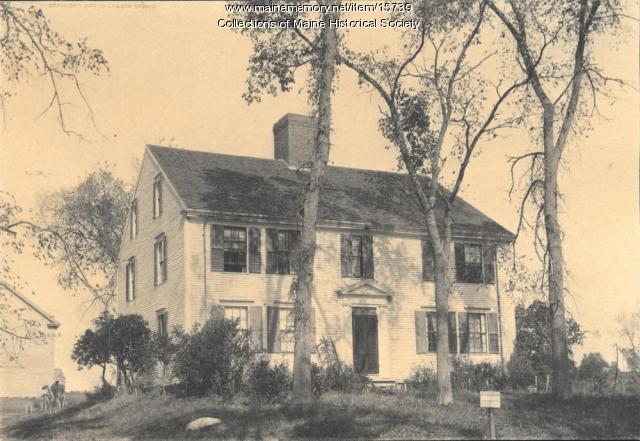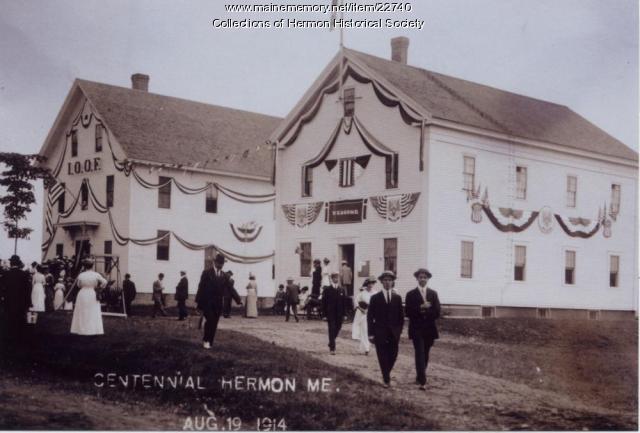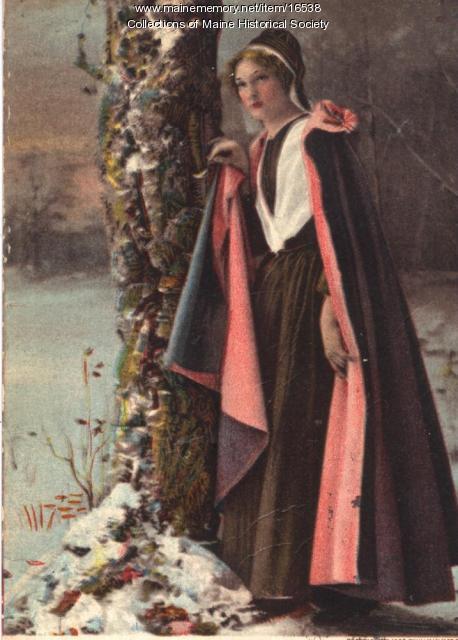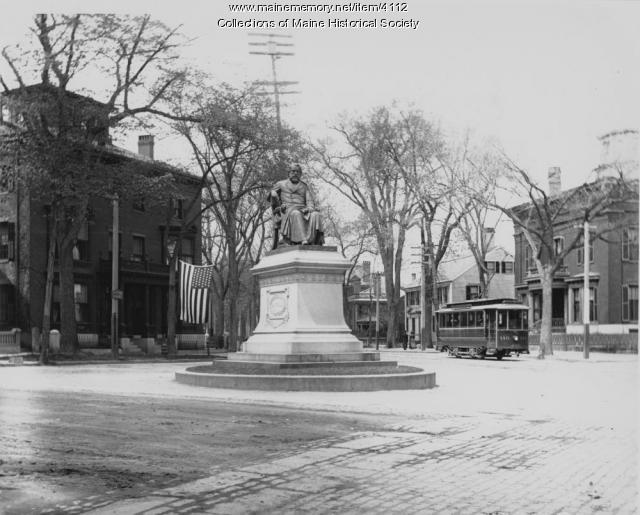Keywords: Somes
- Historical Items (1058)
- Tax Records (4)
- Architecture & Landscape (5)
- Online Exhibits (225)
- Site Pages (517)
- My Maine Stories (91)
- Lesson Plans (21)
Lesson Plans
Your results include these lesson plans. Your results include these lesson plans.
Lesson Plan
Longfellow Studies: "Christmas Bells"
Grade Level: 6-8, 9-12
Content Area: English Language Arts, Social Studies
The words of this poem are more commonly known as the lyrics to a popular Christmas Carol of the same title. Henry Wadsworth Longfellow wrote "Christmas Bells" in December of 1863 as the Civil War raged. It expresses his perpetual optimism and hope for the future of mankind. The poem's lively rhythm, simple rhyme and upbeat refrain have assured its popularity through the years.
Lesson Plan
Longfellow Studies: "The Poet's Tale - The Birds of Killingworth"
Grade Level: 6-8, 9-12
Content Area: English Language Arts, Science & Engineering, Social Studies
This poem is one of the numerous tales in Henry Wadsworth Longfellow's Tales of the Wayside Inn. The collection was published in three parts between 1863 and 1873. This series of long narrative poems were written by Longfellow during the most difficult personal time of his life. While mourning the tragic death of his second wife (Fanny Appleton Longfellow) he produced this ambitious undertaking. During this same period he translated Dante's Inferno from Italian to English. "The Poet's Tale" is a humorous poem with a strong environmental message which reflects Longfellow's Unitarian outlook on life.
Lesson Plan
Longfellow Studies: "Haunted Houses"
Grade Level: 6-8, 9-12
Content Area: English Language Arts, Social Studies
Longfellow's collection The Courtship of Miles Standish and other Poems was published in 1858. It sold 250,000 copies in two months and over 10.000 copies in London on the first day; Henry Wadsworth Longfellow was extremely popular during his lifetime.
"Haunted Houses" is a work from that collection. It is a poem that is especially appealing around Halloween. The poem welcomes the reader to a place where "The spirit-world around the world of sense floats like an atmosphere . . ."
Lesson Plan
Longfellow Studies: "The Slave's Dream"
Grade Level: 6-8, 9-12
Content Area: English Language Arts, Social Studies
In December of 1842 Henry Wadsworth Longfellow's Poems on Slavery was published. "The Slave's Dream" is one of eight anti-slavery poems in the collection. A beautifully crafted and emotionally moving poem, it mesmerizes the reader with the last thoughts of an African King bound to slavery, as he lies dying in a field of rice. The 'landscape of his dreams' include the lordly Niger flowing, his green-eyed Queen, the Caffre huts and all of the sights and sounds of his homeland until at last 'Death illuminates his Land of Sleep.'
Lesson Plan
World War I Sacrifice and Protest
Grade Level: 9-12
Content Area: Social Studies
Learn about World War I using primary sources from Maine Memory Network and the Library of Congress.
Lesson Plan
Longfellow Studies: The Elms - Stephen Longfellow's Gorham Farm
Grade Level: 6-8, 9-12
Content Area: English Language Arts, Social Studies
On April 3, 1761 Stephen Longfellow II signed the deed for the first 100 acre purchase of land that he would own in Gorham, Maine. His son Stephen III (Judge Longfellow) would build a home on that property which still stands to this day. Judge Longfellow would become one of the most prominent citizens in Gorhams history and one of the earliest influences on his grandson Henry Wadsworth Longfellow's work as a poet.
This exhibit examines why the Longfellows arrived in Gorham, Judge Longfellow's role in the history of the town, Henry Wadsworth Longfellow's vacations in the country which may have influenced his greatest work, and the remains of the Longfellow estate still standing in Gorham today.
Lesson Plan
Primary Sources: Healthcare History in Maine
Grade Level: 6-8, 9-12
Content Area: Social Studies
This lesson plan will give students the opportunity to read and analyze letters, literature, and other primary documents and articles of material culture from the MHS collections relating to how people in Maine have given and received healthcare throughout history. Students will discuss the giving and receiving of medicines and treatments from the 18th-21st centuries, the evolving role of hospitals since the 19th century, and how the nursing profession has changed since the Civil War. Students will also look at how people and healthcare facilities in Maine have addressed epidemics in the past, such as influenza and tuberculosis, and what we can learn today from studying the history of healthcare and medicine.
Lesson Plan
Primary Sources: Museum Practices for Students
Grade Level: K-2, 3-5
Content Area: Social Studies
Included here are some basics about general museum etiquette and ways to enable your students a greater understanding of museums, artifacts and their significance in illustrating history.
Lesson Plan
Grade Level: 3-5, 6-8, 9-12
Content Area: Social Studies, Visual & Performing Arts
"In the four quarters of the globe, who reads an American book?" Englishman Sydney Smith's 1820 sneer irked Americans, especially writers such as Irving, Cooper, Hawthorne, and Maine's John Neal, until Henry Wadsworth Longfellow's resounding popularity successfully rebuffed the question. The Bowdoin educated Portland native became the America's first superstar poet, paradoxically loved especially in Britain, even memorialized at Westminster Abbey. He achieved international celebrity with about forty books or translations to his credit between 1830 and 1884, and, like superstars today, his public craved pictures of him. His publishers consequently commissioned Longfellow's portrait more often than his family, and he sat for dozens of original paintings, drawings, and photos during his lifetime, as well as sculptures. Engravers and lithographers printed replicas of the originals as book frontispiece, as illustrations for magazine or newspaper articles, and as post cards or "cabinet" cards handed out to admirers, often autographed. After the poet's death, illustrators continued commercial production of his image for new editions of his writings and coloring books or games such as "Authors," and sculptors commemorated him with busts in Longfellow Schools or full-length figures in town squares. On the simple basis of quantity, the number of reproductions of the Maine native's image arguably marks him as the country's best-known nineteenth century writer. TEACHERS can use this presentation to discuss these themes in art, history, English, or humanities classes, or to lead into the following LESSON PLANS. The plans aim for any 9-12 high school studio art class, but they can also be used in any humanities course, such as literature or history. They can be adapted readily for grades 3-8 as well by modifying instructional language, evaluation rubrics, and targeted Maine Learning Results and by selecting materials for appropriate age level.
Lesson Plan
Grade Level: 6-8, 9-12, Postsecondary
Content Area: Social Studies
This lesson presents an overview of the history of the LGBTQ community in Maine and the U.S., including the ways in which attitudes towards the LGBTQ community have changed over time, some of the ways LGBTQ people have faced discrimination and unfair treatment, and some of the moments in Maine and U.S. history that inspired LGBTQ people and their allies to fight for equality and LGBTQ rights.
Lesson Plan
Portland History: The Portland Observatory and Thermometrics
Grade Level: 3-5, 6-8
Content Area: Science & Engineering, Social Studies
Thermometrics is a term coined by Moody to describe his weather recording activities. Included here are some cross-curricula lesson plans and activities for students to use their knowledge in science, math and social studies while acting as weather forecasters. Check out the web-sites listed in this section for information on building your own barometer and anemometer.
Lesson Plan
Grade Level: 3-5
Content Area: Health Education & Physical Education, Social Studies
This lesson plan will introduce students to myriad communities in Maine, past and present, through the universal lens of sports and group activities. Students will explore and understand the history of many of Maine’s recreational pastimes, what makes Maine the ideal location for some outdoor sports, and how communities have come together through team activities throughout Maine’s history.
Lesson Plan
Grade Level: 6-8, 9-12, Postsecondary
Content Area: Social Studies
This lesson presents an overview of the history of Jews in Maine and the U.S., including some of the factors that led to Jewish immigration to the U.S., examination of the prejudice, discrimination and anti-Semitism many Jews have experienced, and the contributions of Jews to community life and culture in Maine.
Lesson Plan
Building Community/Community Buildings
Grade Level: 6-8
Content Area: Social Studies
Where do people gather? What defines a community? What buildings allow people to congregate to celebrate, learn, debate, vote, and take part in all manner of community activities? Students will evaluate images and primary documents from throughout Maine’s history, and look at some of Maine’s earliest gathering spaces and organizations, and how many communities established themselves around certain types of buildings. Students will make connections between the community buildings of the past and the ways we express identity and create communities today.
Lesson Plan
Primary Sources: Maine Women's Causes and Influence before 1920
Grade Level: 6-8
Content Area: Social Studies
This lesson plan will give students the opportunity to read and analyze letters, literature, and other primary documents and articles of material culture from the MHS collections relating to the women of Maine between the end of the Revolutionary War through the national vote for women’s suffrage in 1920. Students will discuss issues including war relief (Civil War and World War I), suffrage, abolition, and temperance, and how the women of Maine mobilized for or in some cases helped to lead these movements.
Lesson Plan
Irish and Ulster Scots in Maine
Grade Level: 6-8, 9-12, Postsecondary
Content Area: Social Studies
This lesson presents an overview of the history of the Irish and Ulster Scots/Scots Irish in Maine and the U.S., including some of the factors that led to their immigration to the U.S., a look into the prejudice and discrimination many Irish and Ulster Scots/Scots Irish experienced, and the contributions of Irish and Ulster Scots/Scots Irish to community life and culture in Maine.
Lesson Plan
Grade Level: 6-8, 9-12, Postsecondary
Content Area: Social Studies
This lesson presents an overview of the history of the Chinese/Chinese Americans in Maine and the U.S. including some of the factors that led to Chinese immigration to the U.S., the history of the Chinese Exclusion Act, a look into the xenophobia, racism, and discrimination many Chinese Americans have experienced and continue to experience, and the contributions of Chinese Americans to community life and culture in Maine.
Lesson Plan
Longfellow Studies: The Acadian Diaspora - Reading "Evangeline" as a Feminist and Metaphoric Text
Grade Level: 6-8, 9-12
Content Area: English Language Arts, Social Studies
Evangeline, Longfellow's heroine, has long been read as a search for Evangeline's long-lost love, Gabrielle--separated by the British in 1755 at the time of the Grand Derangement, the Acadian Diaspora. The couple comes to find each other late in life and the story ends. Or does it?
Why does Longfellow choose to tell the story of this cultural group with a woman as the protagonist who is a member of a minority culture the Acadians? Does this say something about Longfellow's ability for understanding the misfortunes of others?
Who is Evangeline searching for? Is it Gabriel, or her long-lost land of Acadia? Does the couple represent that which is lost to them, the land of their birth and rebirth? These are some of the thoughts and ideas which permeate Longfellow's text, Evangeline, beyond the tale of two lovers lost to one another. As the documentary, Evangeline's Quest (see below) states: "The Acadians, the only people to celebrate their defeat." They, as a cultural group, are found in the poem and their story is told.
Lesson Plan
Longfellow Studies: Longfellow Amongst His Contemporaries - The Ship of State DBQ
Grade Level: 9-12
Content Area: English Language Arts, Social Studies
Preparation Required/Preliminary Discussion:
Lesson plans should be done in the context of a course of study on American literature and/or history from the Revolution to the Civil War.
The ship of state is an ancient metaphor in the western world, especially among seafaring people, but this figure of speech assumed a more widespread and literal significance in the English colonies of the New World. From the middle of the 17th century, after all, until revolution broke out in 1775, the dominant system of governance in the colonies was the Navigation Acts. The primary responsibility of colonial governors, according to both Parliament and the Crown, was the enforcement of the laws of trade, and the governors themselves appointed naval officers to ensure that the various provisions and regulations of the Navigation Acts were executed. England, in other words, governed her American colonies as if they were merchant ships.
This metaphorical conception of the colonies as a naval enterprise not only survived the Revolution but also took on a deeper relevance following the construction of the Union. The United States of America had now become the ship of state, launched on July 4th 1776 and dedicated to the radical proposition that all men are created equal and endowed with certain unalienable rights. This proposition is examined and tested in any number of ways during the decades between the Revolution and the Civil War. Novelists and poets, as well as politicians and statesmen, questioned its viability: Whither goes the ship of state? Is there a safe harbor somewhere up ahead or is the vessel doomed to ruin and wreckage? Is she well built and sturdy or is there some essential flaw in her structural frame?
Lesson Plan
Grade Level: 9-12
Content Area: Social Studies, Visual & Performing Arts
When European settlers began coming to the wilderness of North America, they did not have a vision that included changing their lifestyle. The plan was to set up self-contained communities where their version of European life could be lived. In the introduction to The Crucible, Arthur Miller even goes as far as saying that the Puritans believed the American forest to be the last stronghold of Satan on this Earth. When Roger Chillingworth shows up in The Scarlet Letter's second chapter, he is welcomed away from life with "the heathen folk" and into "a land where iniquity is searched out, and punished in the sight of rulers and people." In fact, as history's proven, they believed that the continent could be changed to accommodate their interests. Whether their plans were enacted in the name of God, the King, or commerce and economics, the changes always included and still do to this day - the taming of the geographic, human, and animal environments that were here beforehand.
It seems that this has always been an issue that polarizes people. Some believe that the landscape should be left intact as much as possible while others believe that the world will inevitably move on in the name of progress for the benefit of mankind. In F. Scott Fitzgerald's The Great Gatsby a book which many feel is one of the best portrayals of our American reality - the narrator, Nick Carraway, looks upon this progress with cynicism when he ends his narrative by pondering the transformation of "the fresh green breast of a new world" that the initial settlers found on the shores of the continent into a modern society that unsettlingly reminds him of something out of a "night scene by El Greco."
Philosophically, the notions of progress, civilization, and scientific advancement are not only entirely subjective, but also rest upon the belief that things are not acceptable as they are. Europeans came here hoping for a better life, and it doesn't seem like we've stopped looking. Again, to quote Fitzgerald, it's the elusive green light and the "orgiastic future" that we've always hoped to find. Our problem has always been our stoic belief system. We cannot seem to find peace in the world either as we've found it or as someone else may have envisioned it. As an example, in Miller's The Crucible, his Judge Danforth says that: "You're either for this court or against this court." He will not allow for alternative perspectives. George W. Bush, in 2002, said that: "You're either for us or against us. There is no middle ground in the war on terror." The frontier -- be it a wilderness of physical, religious, or political nature -- has always frightened Americans.
As it's portrayed in the following bits of literature and artwork, the frontier is a doomed place waiting for white, cultured, Europeans to "fix" it. Anything outside of their society is not just different, but unacceptable. The lesson plan included will introduce a few examples of 19th century portrayal of the American forest as a wilderness that people feel needs to be hesitantly looked upon. Fortunately, though, the forest seems to turn no one away. Nature likes all of its creatures, whether or not the favor is returned.
While I am not providing actual activities and daily plans, the following information can serve as a rather detailed explanation of things which can combine in any fashion you'd like as a group of lessons.
Lesson Plan
Longfellow Studies: An American Studies Approach to Henry Wadsworth Longfellow
Grade Level: 6-8, 9-12
Content Area: English Language Arts, Social Studies
Henry Wadsworth Longfellow was truly a man of his time and of his nation; this native of Portland, Maine and graduate of Bowdoin College in Brunswick, Maine became an American icon. Lines from his poems intersperse our daily speech and the characters of his long narrative poems have become part of American myth. Longfellow's fame was international; scholars, politicians, heads-of-state and everyday people read and memorized his poems. Our goal is to show that just as Longfellow reacted to and participated in his times, so his poetry participated in shaping and defining American culture and literature.
The following unit plan introduces and demonstrates an American Studies approach to the life and work of Longfellow. Because the collaborative work that forms the basis for this unit was partially responsible for leading the two of us to complete the American & New England Studies Masters program at University of Southern Maine, we returned there for a working definition of "American Studies approach" as it applies to the grade level classroom. Joe Conforti, who was director at the time we both went through the program, offered some useful clarifying comments and explanation. He reminded us that such a focus provides a holistic approach to the life and work of an author. It sets a work of literature in a broad cultural and historical context as well as in the context of the poet's life. The aim of an American Studies approach is to "broaden the context of a work to illuminate the American past" (Conforti) for your students.
We have found this approach to have multiple benefits at the classroom and research level. It brings the poems and the poet alive for students and connects with other curricular work, especially social studies. When linked with a Maine history unit, it helps to place Portland and Maine in an historical and cultural context. It also provides an inviting atmosphere for the in-depth study of the mechanics of Longfellow's poetry.
What follows is a set of lesson plans that form a unit of study. The biographical "anchor" that we have used for this unit is an out-of-print biography An American Bard: The story of Henry Wadsworth Longfellow, by Ruth Langland Holberg, Thomas Y. Crowell & Company, c1963. Permission has been requested to make this work available as a downloadable file off this web page, but in the meantime, used copies are readily and cheaply available from various vendors. The poem we have chosen to demonstrate our approach is "Paul Revere's Ride." The worksheets were developed by Judy Donahue, the explanatory essays researched and written by the two of us, and our sources are cited below. We have also included a list of helpful links. When possible we have included helpful material in text format, or have supplied site links. Our complete unit includes other Longfellow poems with the same approach, but in the interest of time and space, they are not included. Please feel free to contact us with questions and comments.



















